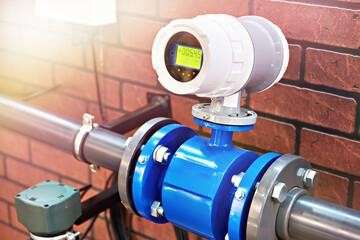Faraday’s Law of Electromagnetic Induction is used by magnetic flow meters to calculate the speed of a liquid flowing through a conduit. Electrical generating systems, in which wires move through a magnetic field and generate a voltage, are based on Faraday’s Law. A magnetic field is created and directed into the liquid passing through the pipe in magnetic flow meters.
The electromagnetic coils can be placed outside of the pipe to do this, but the flow tube has to be non-magnetic to allow the magnetic field to enter the liquid.
It is possible to lower the amount of electrical power required to deliver the magnetic field, as well as the size of the flow meter and the cost of production, by placing the coils inside the flow meter (closer to the liquid).
According to Faraday’s Law, a voltage signal will be produced when a conductive liquid flows through a magnetic field. Electrodes mounted on the flow tube walls detect this signal. When the coils are placed outside, the flow tube is lined with a non-conductive material to electrically separate the electrodes and guard against signal shorting.
Non-conductive materials isolate the electrodes for internal coil designs for similar reasons. The fluid’s natural conductivity allows it to move freely across the magnetic field and produce a voltage signal at the electrodes. The fluid travels more quickly, producing a higher voltage.
According to Faraday’s Law, the voltage produced is inversely related to the liquid’s flow rate. To calculate the liquid flow, the transmitter analyzes the voltage signal. Other types of flow meters that are manufactured by flow meter suppliers in India are ultrasonic flow meters, vortex flow meters, orifice plate flow meters, and thermal flow meters.
How are Magnetic flow meters used: Functions
Water, acids, caustics, and other conductive liquids such as slurries and water are measured by magnetic flow meters for their velocity in pipes. When the liquid’s electrical conductivity is higher than around 5 S/cm, magnetic flow meters can measure it accurately. Magnetic flow meters may shut off and register zero flow when used with low-conductivity fluids like deionized water, boiler feed water, or hydrocarbons.
They may be used for clean, hygienic, impure, corrosive, and abrasive liquids since these flow meters do not restrict flow. This technique cannot monitor gases or hydrocarbons since they are non-conductive and in a gaseous state, respectively. Magnetic flow meters can only be used to monitor the flow of conductive fluids.
Magnetic flow meters may be put in relatively short meter lines since they just need a small amount of upstream and downstream straight runs. For magnetic flow meters, standard straight lines measuring from the plane of the electrodes need 5–10 diameters upstream and 5-2 diameters downstream.
Applications of Electromagnetic Flow Meters
The water, wastewater, mining, mineral processing, electricity, pulp and paper, and chemical industries all use unclean liquids in some capacity. Magnetic flow meters are used in water treatment plants to keep an eye on water, chemicals, processed water, and both treated and untreated sewage. Process water flows, process slurry flows, and heavy media flows are all used in mining and mineral processing.
The flow of extremely corrosive liquids (such as acid and caustic) and abrasive slurries may be monitored with careful attention to the building materials. In chemical industry processes and in chemical feed systems utilized in most industries, corrosive liquid applications are frequently seen. Applications for slurry are frequently found in the wastewater, pulp and paper, mining, and mineral processing sectors.
In situations where the liquid is supplied by gravity, magnetic flow meters are frequently utilized. Make sure the flow meter is oriented so that the whole inside is filled with liquid. The flow measurement might be greatly impacted if the flow meter is not fully filled with liquid.
When using magnetic flow meters in vacuum operations, exercise caution since some magnetic flow meter liners have the potential to collide and be pulled into the pipeline, severely destroying the flow meter. Be aware that pipelines that don’t seem to be exposed to vacuum service, such as pipes where gas might condense, can really experience vacuum conditions. Similarly, even a slight increase in temperature in atypical circumstances might permanently harm magnetic flow meters.

As the editor of the blog, She curate insightful content that sparks curiosity and fosters learning. With a passion for storytelling and a keen eye for detail, she strive to bring diverse perspectives and engaging narratives to readers, ensuring every piece informs, inspires, and enriches.










